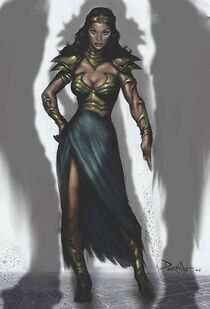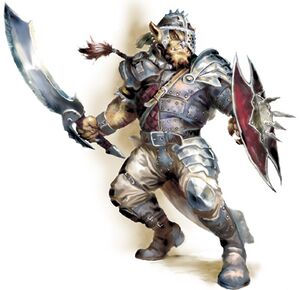Difference between revisions of "Armor (D&D equipment)"
(Rules) |
(Rules) |
(No difference)
| |
Revision as of 22:25, 11 September 2007
 | |
| Unofficial rules compendium | |
|
|
- This helmet, I suppose,
- Was meant to ward off blows,
- It's very hot
- And weighs a lot,
- As many a guardsman knows.
- -- Gilbert & Sullivan, Princess Ida
Armor |
Cost |
Armor/Shield Bonus |
Maximum Dex Bonus |
Armor Check Penalty |
Arcane Spell Failure Chance |
Speed |
Weight |
| Light Armor | |||||||
| Piecemeal Bracers | 200 gp | +3 | +4 | 0 | 15% | 20 ft. | 20 lb. |
| Medium Armor | |||||||
| Laminated Breastplate | 100 gp | +4 | +3 | -4 | 30% | 20 ft. | 25 lb. |
| Bronze Breastplate | 200 gp | +4 | +4 | -4 | 25% | 20 ft. | 30 lb. |
| Piecemeal Armor | 400 gp | +4 | +3 | -3 | 20% | 20 ft. | 30 lb. |
Rules
Partial Armor
Partial armor is a template that can be added to any type of worn armor or to any shield except a tower shield.
Partial looks like regular armor, only sections of it has been cut away, leaving the user open to blindside attacks. In order for partial armor to be protective, the wearer has to position himself so that only armored parts are exposed to the enemy. It works well in formation and when aware of the enemy, but is less useful if the fight degenerates to a general melee. A feinted or flat-footed wearer cannot effectively present it to the enemy.
Some partial armor is ceremonial, designed to look exciting and show off the wearer's body to best advantage, and is worn almost as much for show as to fight in. Such armor is often used by gladiators, show-off barbarians, and decadent warriors. In more mundane versions, the back side of the armor is simply removed and is supposed to discourage soldiers from fleeing, as it does not protect the back. City guardsmen, sentries, engineers, and other warriors who are easily surprised or supposed to do other work while in dangerous situations avoid partial armor.
Game rules
Partial armor costs the same as regular armor of the same type, and requires the same armor proficiency feat to use. It weights only half as much, the maximum dexterity bonus increases by one, the armor check penalty decreases by two (to a minimum of 0), and it impacts speed and movement as if it was one category less; medium partial armor is as hindering as normal light armor, heavy partial armor is as hindering as medium armor. This applies to both movement and to the use of feats and abilities restricted by armor type. Partial armor only provides its armor bonus when the wearer is able to use his dexterity bonus to armor class. On the stat block, simply do not include the armor or shield bonus of partial armor in flat-footed armor class.
Regular armor can be redesigned as partial armor at 20% of the original cost and partial armor can be redesigned as regular armor at 50% of regular cost. It is possible to design a set of armor that can be work as either partial or full armor by adding additional pieces; such a kit cost as much as normal armor (added to the cost of the partial armor). Do not include the price of any magic enchantments in the redesign cost, but do include the cost of masterwork quality and special materials.
Examples

|

|

|
The characters above wear partial armor.
Donning Armor
The times noted for donning armor in the PH are excessive; minutes should be rounds.
Armor and Hardness (Optional Rule)
Characters gain Hardness from wearing armor. Light armor confers a Hardness of 1; heavy armor confers a Hardness of 2.
Admantine armor confers more Hardness; 1 point for light admantine armor, 2 points for medium, and three points for light. In this case, the Hardness conferred stacks, so light admantine armor has Hardness 1, medium Hardness 3 and heavy Hardness 5.
Hardness reduces the damage from each incoming attack. The only way to bypass hardness is to do entirely non-physical damage (such as from mind-affecting powers).
| Seal of Approval | |

|
This page is approved by
|